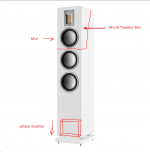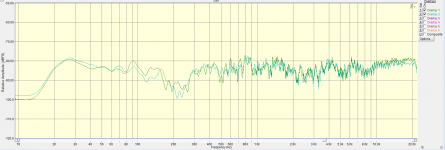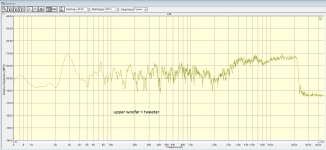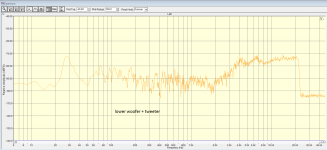[Split from the without measurement thread
** Post #14 - Help with taking measurements
(Hensolo - let me know if you want to change the title of this thread)]
AllenB, hello. There are a few questions about my acoustics. This is an open box with a phase inverter with a rectangular output. Two midbasses, one mid and tweeter. I want to redo the crossover. In the initial state, the manufacturer claims the midbass-mid-400 Hz section frequency, mid-tweeter 3 kHz. With this crossover, the lower middle is in the hollow to - 20 dB from 100 Hz to 300 Hz. The lower midbass is trimmed by a larger inductance coil, the upper midbass is slightly smaller. These are the first orders. The middle from the bottom is cut off in the first order, from the top in the second. Tweeter second. It is a tape. Midbass are turned on in reverse polarity, and the middle and tweeter are in right polarity. When I switch midbass to right polarity, and the middle and tweeter also stay in right polarity, the middle gets better, the bass gets smaller. Which way to go to get a normal lower middle and normal bass? I took measurements of the impedance and phase of the whole system as a whole, the frequency response for each speaker without a filter, with filters and the whole system. The speakers were in regular places.
** Post #14 - Help with taking measurements
(Hensolo - let me know if you want to change the title of this thread)]
AllenB, hello. There are a few questions about my acoustics. This is an open box with a phase inverter with a rectangular output. Two midbasses, one mid and tweeter. I want to redo the crossover. In the initial state, the manufacturer claims the midbass-mid-400 Hz section frequency, mid-tweeter 3 kHz. With this crossover, the lower middle is in the hollow to - 20 dB from 100 Hz to 300 Hz. The lower midbass is trimmed by a larger inductance coil, the upper midbass is slightly smaller. These are the first orders. The middle from the bottom is cut off in the first order, from the top in the second. Tweeter second. It is a tape. Midbass are turned on in reverse polarity, and the middle and tweeter are in right polarity. When I switch midbass to right polarity, and the middle and tweeter also stay in right polarity, the middle gets better, the bass gets smaller. Which way to go to get a normal lower middle and normal bass? I took measurements of the impedance and phase of the whole system as a whole, the frequency response for each speaker without a filter, with filters and the whole system. The speakers were in regular places.
Last edited:
I'd want to know why you have a dip at 100-300Hz. Maybe it is the crossover but maybe it is your box.
Please explain, or photograph your box. You say open box with a phase inverter with a rectangular output. Is this cardioid? Is it an open baffle?
Please explain, or photograph your box. You say open box with a phase inverter with a rectangular output. Is this cardioid? Is it an open baffle?
If the crossover is at 400Hz, but the drivers are not in phase below this and they are in phase above it, this could mean that one driver crosses with a steep slope and one uses a shallow slope, so that they deviate with frequency.
GoodThe crossover circuit will be a little later.
All four drivers are doing something different. This is called a 3.5 way system because both woofers cover the bass but they share the midrange differently.
Have you been able to measure this?the lower middle is in the hollow to - 20 dB from 100 Hz to 300 Hz.
Frequency response left and right channel.
My answer appears after 3-5 minutes. It can be fixed?
My answer appears after 3-5 minutes. It can be fixed?
Attachments
Last edited:
Can you show the response with two woofers disconnected, with lower woofer and mid disconnected, and with upper woofer and mid disconnected. (only one channel is necessary, and the tweeter doesn't matter)
This only happens when you are new to the forum. It will be changed very soon.My answer appears after 3-5 minutes. It can be fixed?
"only one channel is necessary" - ok.
Crossover working.
1. "with two woofers disconnected" and "the tweeter doesn't matter" - only mid? Or mid + tweeter?
2. upper woofer + tweeter? Or upper woofer only?
3. lower woofer + tweeter? Or lower woofer only?
Crossover working.
1. "with two woofers disconnected" and "the tweeter doesn't matter" - only mid? Or mid + tweeter?
2. upper woofer + tweeter? Or upper woofer only?
3. lower woofer + tweeter? Or lower woofer only?
I see three things happening in the 170Hz-270Hz region. The lower woofer is cutting out, the midrange is cutting out and the upper woofer is offering some dips which may be related to room reflections.
I also notice they don't add up the way they would if they had a better phase relationship. The quick answer would be to try reversing the phase of some of the drivers.
Since you are measuring, it would be worth getting quasi-anechoic measurements and using a simulator. Maybe you could start a thread to that effect. The levels, response shapes and phase relationships could be adjusted. There is some tweaking of the upper crossover that could be done as well.
I also notice they don't add up the way they would if they had a better phase relationship. The quick answer would be to try reversing the phase of some of the drivers.
Since you are measuring, it would be worth getting quasi-anechoic measurements and using a simulator. Maybe you could start a thread to that effect. The levels, response shapes and phase relationships could be adjusted. There is some tweaking of the upper crossover that could be done as well.
How should the speakers be connected for near field measurement (0,5 sm from the diaphragm)? For example, am I measuring the lower woofer, should the other speakers work or should be turned off?
You probably do not have to do this because your interest is above 100Hz (it has the potential to become complicated, but we can discuss it if you like)
Measuring at a distance will give a better account of the baffle, and your issue is below or around this region. Can you take the speaker outside so you can lift it off the ground and test for the floor reflection?
Measuring at a distance will give a better account of the baffle, and your issue is below or around this region. Can you take the speaker outside so you can lift it off the ground and test for the floor reflection?
I think I learned how to do Quasi anechoic loudspeaker measurements. Something has already been measured. For example, lower woofer + tweeter + port. But I'm not sure that is right. It may be necessary during the measurement to work all the speakers. They exert their influence, and if they are excluded from the measurement, there will be an inaccurate picture. What is your opinion?
While I was typing a message, you added a response. But I still want to know the answer to my question. Because during measuring in a very near field, I saw that the port of the bass reflex has peaks in the range up to 1000 Hz, which have a level as the main signal. but in antiphase. Maybe it needs to be fixed. And then I can get any speaker out of the case. And measure what need.
While I was typing a message, you added a response. But I still want to know the answer to my question. Because during measuring in a very near field, I saw that the port of the bass reflex has peaks in the range up to 1000 Hz, which have a level as the main signal. but in antiphase. Maybe it needs to be fixed. And then I can get any speaker out of the case. And measure what need.
Last edited:
Sometimes no, sometimes yes. I would want to identify something along the lines of the following..to work all the speakers. They exert their influence, and if they are excluded from the measurement, there will be an inaccurate picture. What is your opinion?
a. the floor bounce for each driver
b. the baffle effects through the midrange for each driver
c. the other room effects in the lower midrange
d. the proper usage and crossing of each driver
e. the relative phase of the each driver
f. the anechoic total
g. the in room total
Yes, this could be important. What have you done to stop this? Can you describe the box stuffing? Do the two woofers work into the same part of the box?the port of the bass reflex has peaks in the range up to 1000 Hz, which have a level as the main signal. but in antiphase. Maybe it needs to be fixed.
In the picture in post No. 3 3.5 Way Crossover with Measurements I drew a box for the midrange and treble. The rest of the space inside is for two woofers. Behind the woofers is one space. At the bottom is the port. There are reinforcing partitions, but they are close to the walls and have a distance of 2-3 cm from the walls. Air can freely move throughout the housing, except for a separate box for the mid-high frequency. Inside on the walls absorber except the front.
Last edited:
- Home
- Loudspeakers
- Multi-Way
- 3.5 Way Crossover with Measurements





